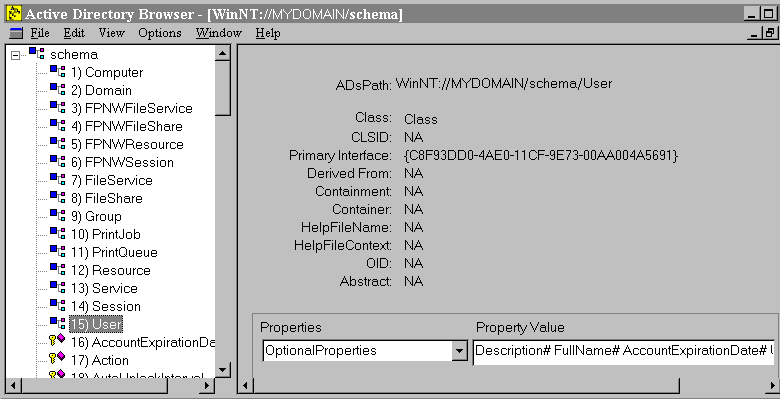
The WinNT provider represents the underlying directory service by defining about a dozen ADSI object types such as Users, Computers, Domains, Groups, and Services. To find out which properties and classes are supported on each of these object types, you can bind to and enumerate the schema container object of the specific WinNT server or workstation on your network. For example, the following figure uses a browser view to show the schema container object at "WinNT://MyDomain/schema". By double-clicking on the schema object, the browser expands the view to show all the class, property, and syntax objects.

In the preceding figure, the left pane highlights the last class object "User" followed by a list of all the property objects in the schema container. The right pane's Properties list box shows "OptionalProperties" for the User class and lists its value as "Description#FullName#AccountExpirationDate#", etc. These are the properties that may, but don't have to be, defined before an IADs::SetInfo writes the property information from the property cache out to the WinNT directory service. For further information, see WinNT Schema Class Mandatory and Optional Properties.
The IADsClass methods Containment and PossibleSuperiors define the containment relationships among the object classes. The Containment property defines which objects this object can contain and the PossibleSuperiors property defines which objects can contain this object. The following table shows the WinNT object hierarchy as defined in the schema.
| Object Class Hierarchy | Definition of Object |
|---|---|
| WinNT Namespace | Top-level container object. |
| Domains | Domain servers. |
| Users | User accounts. |
| Groups | Administrator-assigned groups that manage access rights. |
| Collection of Users through IADsMembers | |
| Other groups through IADsMembers | |
| Computers | Some type of server or workstation. |
| PrintQueues | Print queues on a print spooler. |
| Collections of PrintJobs | Print jobs queued on a print spooler. |
| Services | Any computer software that performs a service. |
| FileServices | Session connections and resource management. |
| FileShares | Directory file share points. |
| Collections of Resources | Resources within the directory service, such as a groups, print queues, or computer servers. |
| Collections of Sessions | Active connections for any file service. |
| Users | User accounts. |
| Groups | Administrator-assigned groups that manage access rights. |